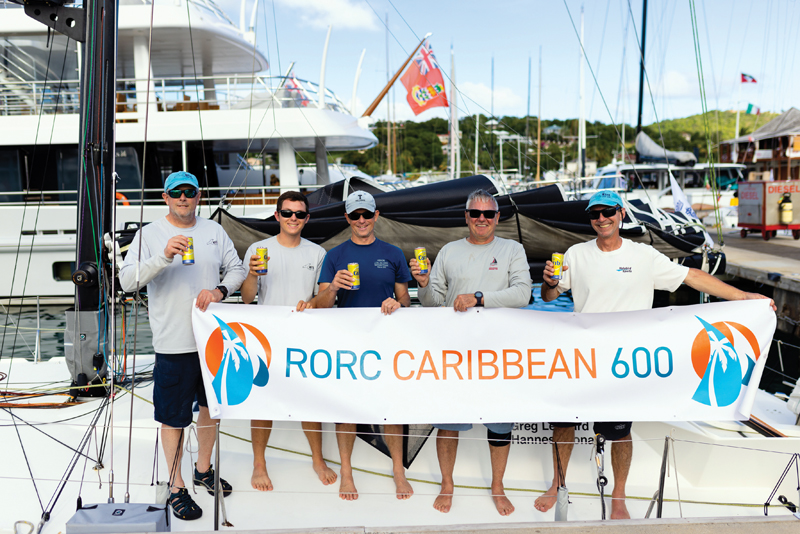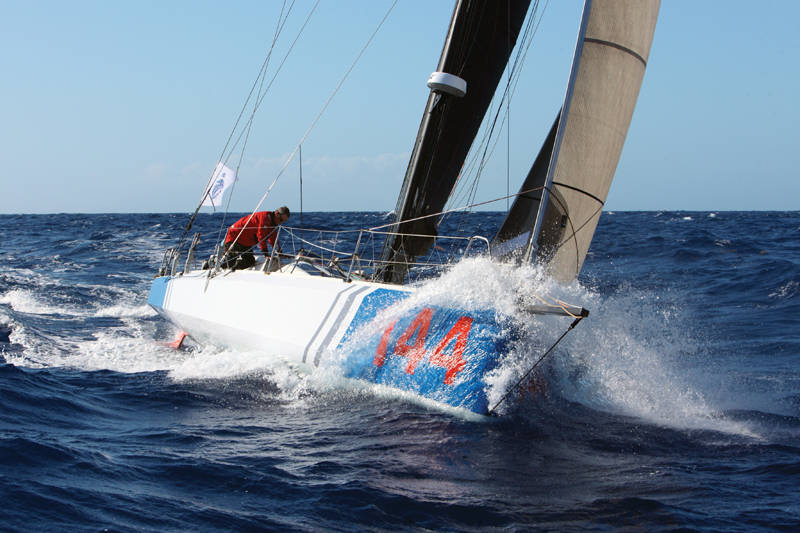A Chesapeake Bay crew reunites for the Caribbean 600
The Royal Ocean Racing Club’s Caribbean 600 and the welcoming hospitality of Antigua provided the perfect opportunity for five Annapolis-area sailors to meet up for a few days of sailing and fun. Blue skies, blue water, steady breeze: what better way for a Chesapeake race crew to reunite after several years of separation?

Ted Lepich, Sean Reilly, and Denis Hope-Ross joined my dad Greg Leonard and me to race for three days aboard our Class40 Kite. Ten years ago, I learned to race with this crew aboard my family’s J/120 Heron. I loved sailing in classic Chesapeake races such as the Down the Bay Race and the Governor’s Cup. Now, we would all race together again in the tropics.
Renowned for its challenging course, the Royal Ocean Racing Club’s (RORC) Caribbean 600 stretches approximately 600 miles through the northeastern Caribbean. After three years of Class40 racing in Europe, my dad and I were looking forward to the promise of warm weather and trade winds that Caribbean sailing brings. Following the transatlantic Route du Rhum, this year’s race featured a particularly good showing of Class 40s with 13 boats lining up to start, including seven of the recently designed “scow-bow” boats (which are significantly faster off the wind).
Unrelenting competition
From the outset, the intensity of the racing stood out. The multihull class line honors were decided by 11 seconds. With most of the Class40 fleet raced by professional crews, the competition was unrelenting. The race course contained frequent turns, making it a challenge to settle in and requiring constant attention and frequent sail changes. The course felt much more like 12 back-to-back Chesapeake Bay distance races than an offshore race. The many short legs meant that it was particularly challenging to find time to rest and eat. An added challenge was the impact of the high, volcanic islands on the wind. Some islands blocked the wind completely, resulting in zones of extremely light air, while the wind funneled around others, resulting in strange wind angles and strong gusts.

After beating up the south coast of Antigua following the start, we got a full set of conditions to test our prowess. Beats changed to downwind legs which changed to reaches and back again. Class 40 sailing is technical, necessitating a lot of sail changes with extra steps compared to a traditional race boat. With every maneuver came a slew of tasks above and below deck. From moving hundreds of kilos of gear around to hauling the next sail on deck, this amounted to a strenuous workout that never let up. Denis described the feelings of the crew towards sailing the Class40, saying, “The French have been developing the ultimate torture machine, and with the Class40, they have very nearly perfected it.” No wonder we were ready for burgers and beer at the finish line.
The rounding of Guadeloupe proved especially challenging for us. After having a relatively easy escape from the notoriously challenging wind shadow in the lee of Basse Terre, we were sailing steadily just east of Les Saintes, the most southerly point of the course, when we caught a fish-attracting device on our keel. These devices consist of hundreds of meters of plastic line with rocks and shells tied to it that local fishermen use to attract fish. As we learned the hard way, they are often only marked by a small float, often in the form of an empty bottle.
Unfortunately, our attempts to back down and sail free of the lines only resulted in putting more wraps around the keel and rudders. After about an hour of drifting, we were able to cut all of the lines free except a 30-foot piece that had carved a four-inch groove in the keel. Freeing this required sailing into the lee of Marie-Galante where it was calm enough to dive on the keel and remove the line. This adventure completed, we set off north to round Le Desirade and continue towards Barbuda.
With 75 hours and 600-plus miles behind us, we happily crossed the finish line. A lovely welcome party met us at the dock with a case of beer. Post-race celebrations ensued. Later in the week, the RORC hosted a fun-filled awards party, and our crew had a great time reliving old stories and enjoying the charms of Antigua.
By Hannes Leonard
About the Author: Having grown up racing, cruising, and living aboard on the Chesapeake, 19-year-old Hannes Leonard now races aboard the Class40 Kite with his dad, Greg.




